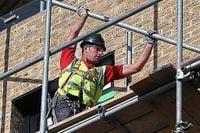London, once a city synonymous with cranes dotting the skyline and the constant hum of construction, is facing an unprecedented housing crisis. According to a new report from the Home Builders Federation (HBF), housing delivery in the capital has not only slowed—it has hit a wall. The numbers paint a sobering picture: both the supply of new homes and the demand from buyers have plummeted, raising serious questions about whether London can meet its share of the government’s ambitious national housing targets by 2030.
The government’s plan is for 1.5 million new homes to be built across England by 2030, with London expected to deliver a hefty 440,000 of those. But the HBF’s latest figures, as reported by multiple sources including the Home Builders Federation and industry analyst Molior, show that the capital is dramatically off course.
In the year to June 2025, only 30,000 homes were completed in London—a 12% drop from the previous year and far below the peak seen in 2019/20. Planning permissions for new projects have also taken a nosedive, falling to their lowest level since records began in 2006. Just 966 projects were approved in the 12 months leading up to June 2025, a figure that’s not just disappointing, but alarming for those watching the city’s future unfold.
Perhaps most shocking is the collapse in sales of new build private homes. According to Land Registry records cited by industry insiders, sales have dropped to their lowest level in history. Historically, London could count on around 1,000 new build home sales a month, with a high of 1,844 in June 2017. Even during the depths of the post-2008 financial crisis, sales never dipped below 369 in a single month. Yet now, the market is in uncharted territory, with sales figures well below these historic lows.
Tim Craine, founder and director of Molior, didn’t mince words. “Residential development in London has stopped, it no longer happens,” he stated, reflecting the research his firm has done on the ground. Molior’s team visited 1,400 development sites in London during the third quarter of 2025 and found that only 16 had started construction. Their research estimates that fewer than 1,000 homes commenced construction in London during that period—putting the city on track for a mere 5,000 residential construction starts for all of 2025. For a city of nearly nine million, that’s a drop in the ocean.
So what’s behind this dramatic slowdown? The reasons are many and interconnected, forming a web of challenges that’s proven difficult to untangle. The HBF’s report points to a lack of support for buyers, excessive bureaucracy, and what it calls “unrealistic” affordable housing demands from City Hall. Developers also face huge delays in getting planning applications approved, particularly since the introduction of the Building Safety Regulator in 2022. This new layer of oversight, established in the wake of the Grenfell Tower tragedy, was meant to ensure higher standards—but it’s also created a backlog that has stymied new projects.
According to Molior, about 90% of unbuilt planning permissions involve buildings over six storeys, meaning they’re caught in this regulatory bottleneck. There are currently unbuilt permissions for 281,000 homes across the capital, but many of these sites are now “ghost sites” where little or no work is happening. Half of these unbuilt permissions are in areas where sales values are below £650 per square foot, making development financially unviable given rising construction costs and stagnant real incomes since the 2008 banking crisis.
The disappearance of off-plan foreign buyers—who once helped finance development costs—and the end of the government’s Help to Buy scheme in 2023 have further eroded demand. For the first time in decades, there is no government support for first-time buyers, a fact that’s hit London especially hard. The HBF’s chief executive, Neil Jefferson, was blunt in his assessment: Sir Sadiq Khan’s development strategy for the capital “effectively made London a no-go zone for housing investment.” The Mayor’s affordable housing targets, described by the HBF as “unrealistic,” are seen by developers as strangling attempts to build new homes.
Meanwhile, London’s share of national housing delivery has shrunk from 20% a decade ago to just 15% today. The number of new home building sites starting has fallen by 38%. With the government’s Standard Method requiring London to deliver 88,000 homes a year, output would need to more than double—an increase of 175%—to meet that target. That’s not just a steep hill to climb; it’s a mountain.
The impact on would-be homeowners is profound. The housing affordability crisis is biting hard, with first-time buyers facing the highest barriers to entry in the country. According to the HBF report, a first-time buyer in London would need to save 50% of their discretionary income for more than 13 years just to afford a deposit. The average deposit now amounts to nearly seven times annual income after bills. The house price-to-earnings ratio in London stands at 11, compared to 7.7 nationwide, and the average cost of a first home is now 17 times the net annual salary of a 22- to 29-year-old. It’s no wonder many young Londoners feel that home ownership is slipping further out of reach with every passing year.
It’s not just buyers who are struggling. Developers, too, are facing a perfect storm of challenges. Soaring construction costs, regulatory delays, and the lack of viable sites are making it nearly impossible to bring new homes to market. The situation is further complicated by the government’s demand for affordable housing—a noble goal, but one that many in the industry say is unworkable under current market conditions.
As the crisis deepens, the finger-pointing has begun in earnest. The Home Builders Federation and industry analysts blame excessive red tape and City Hall’s demands. The Mayor’s office, for its part, points to the need for safety and affordability. Meanwhile, the government’s targets remain in place, even as the gap between ambition and reality widens by the day.
For now, Londoners are left in limbo. The cranes have stopped moving, the scaffolding is coming down, and the dream of a new home in the capital is fading for many. Unless there is swift and decisive intervention to address the regulatory logjam, support buyers, and make development viable again, the city’s housing crisis looks set to deepen further.
With the numbers heading in the wrong direction and no easy fixes in sight, London’s housing future hangs in the balance—a stark reminder that ambition alone is not enough to solve a crisis years in the making.




